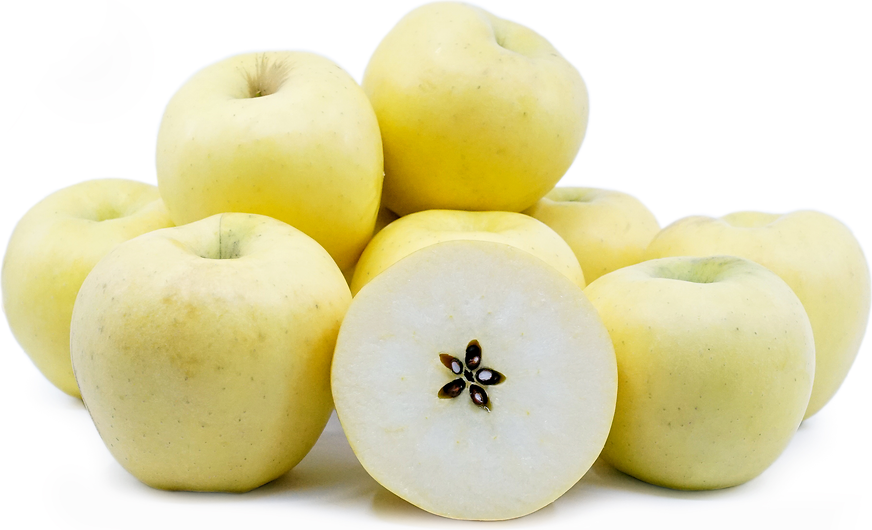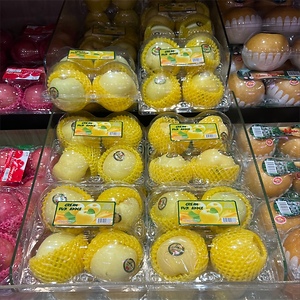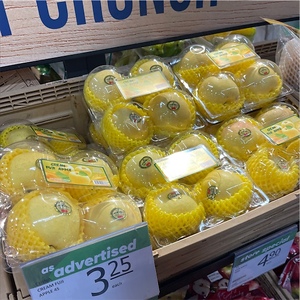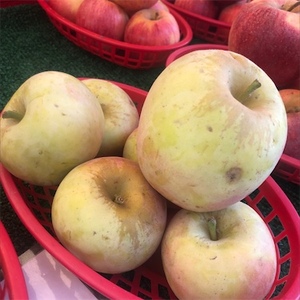


Golden Fuji Apples
Estimated Inventory, 12 ct : 0
Description/Taste
Fuji apples have a round shape that’s slightly flattened at the top and smaller at the bottom. They measure about 7.5 centimeters wide and weigh 160 to 230 grams, denser than the average apple. This variety has a light yellow hue and may be speckled with a few faint, tiny dark dots. Their skin is smooth and delicate while the flesh is firm and juicy. This flesh has a creamy white hue and soft, succulent texture. The core contains about 5 brown seeds that form a star shape when the apple is cut in half. Fuji apples are crispy when bitten into, with a honey-like taste that’s sweeter and lighter than most other varieties.
Seasons/Availability
Golden Fuji apples are harvested mid-fall and available year-round.
Current Facts
The botanical name for Golden Fuji apples is Malus domestica and they are from the Rose family. They are often referred to as Butter or Golden Fuji. This fruit is technically the same variety as Red Fuji apples but with different growing practices. They are covered in bags while ripening to prevent their skin from turning red from the sun and kept on the tree for about one month longer than their red counterparts. This variety is primarily produced in the Chinese city of Yantai, Shandong. Here, there are giant planting areas designated for the cultivation of more than 100 varieties of apples, including the Huaniu, Red Delicious, Ginguan, and Jiguan apples. Golden Fuji apples are prized for their culinary versatility and can be used in both fresh and cooked dishes.
Nutritional Value
Fuji apples like the Golden variety are a rich source of vitamin C and omega-3. These nutrients encourage cell growth, immune function, iron absorption, collagen production, brain and heart health, and help reduce inflammation and free radical damage. They provide a significant amount of fiber to promote digestion, stabilize cholesterol and blood sugar levels, and prevent constipation. This variety contains flavonoids and polyphenols, which help lower inflammation and oxidation stress and contribute to brain function. The triterpenoids found in Fuji apples are beneficial to liver health. Consuming these fruits may boost acetylcholine levels, potentially helping prevent age-related decline in brain function. Most of the nutrients in apples are found in and directly under the skin, so they should not be peeled before eating.
Applications
Golden Fujis are often eaten fresh out of hand but can also be baked or puréed. In their fresh form, they can be enjoyed as a snack with walnuts, almonds, cranberries, pears, citrus, hard cheeses, or peanut butter. They can also be sliced up for salads, oatmeal, sandwiches, pizzas, and wraps. This variety is incorporated into drinks like apple juice, smoothies, cocktails, ciders, and Ponche Navideño, a Mexican Christmas punch. When cooked, Golden Fuji apples work well in baked goods like cakes, tarts, muffins, crumbles, breads, pies, and cinnamon rolls. Carmelized or baked with brown sugar, they can be layered on top of braised pork, roasted chicken, turkey, and ham. This versatile variety can be used as an ingredient in a wide range of applications including apple sauce, stuffing, compote, crepes, soup, and apple sausage. Golden Fuji apples complement a variety of ingredients including kale, spinach, celery, beets, Brussels sprouts, cabbage, fennel, pumpkin, squash, sweet potatoes, onions, pomegranates, pears, raspberries, blackberries, chocolate, cookie butter, vanilla, maple, pecans, and cheeses such as Mascarpone, Swiss, goat cheese, and Brie. Herbs and spices like rosemary, thyme, and sage enhance their flavor, while they work well with meats such as Pancetta, bacon, and carnitas. Fujis will keep for up to three months and do not need to be stored in the refrigerator.
Ethnic/Cultural Info
China produces more apples than any other country and Yantai is considered the nation's modern hometown for apple production. This city has experienced a dramatic surge in apple output since the 1950s, now dedicating 1,700 square kilometers to apple cultivation, about 677 of which are devoted to the Golden Fuji. Yantai produces about 3.6 million tons of apples annually and exports them to over 30 countries, including South Korea, Japan, Russia, and Singapore. In 2013, the value of apples produced in Yantai reached 9.41 billion yuan. The city is also a major producer of pears, grapes, cherries, peaches, and persimmons.
Geography/History
The original Fuji apple was developed by the Tohoku Research Station in Japan in 1939. It was a cross between the Red Delicious and the Ralls Janet varieties. Since their release in 1962, Fujis have started growing across the world, primarily in Japan and the United States. They do best in warmer regions with long hours of sun. Golden Fujis are a recently developed variety that has gained in popularity over the past few years. Outside of the street markets and grocery stores in China, Golden Fujis apples are most likely to be found at specialty stores or Asian supermarkets.
Recipe Ideas
Recipes that include Golden Fuji Apples. One
| Chisel & Fork |
|
Fuji Apple Chips |










